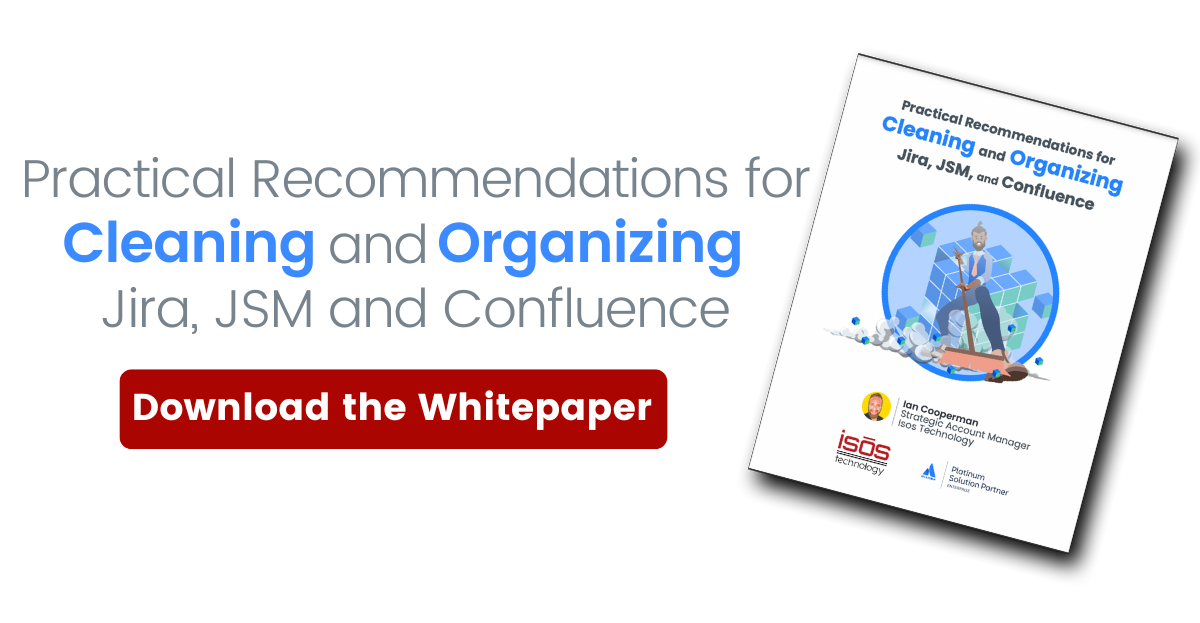 Without regular, focused maintenance, organizations often find that their Atlassian tools become cluttered: new, sometimes duplicate projects get added; new workflows are created, some with only slight differences from existing ones; there are too many custom fields to count; and everyone is using different nomenclature—often for the same thing. JQL queries are slow and return results that aren’t relevant.
Without regular, focused maintenance, organizations often find that their Atlassian tools become cluttered: new, sometimes duplicate projects get added; new workflows are created, some with only slight differences from existing ones; there are too many custom fields to count; and everyone is using different nomenclature—often for the same thing. JQL queries are slow and return results that aren’t relevant.
Eventually, the system can become so cumbersome to work in that users cannot find the information they need to complete work efficiently, and they start running processes outside it. Maybe you're experiencing performance issues and thinking about making hardware investments to fix them–or perhaps you already have, and things haven’t improved much.
If this sounds like your organization–keep reading! Following are the top three reasons to set aside some time to clean and organize your Atlassian instance.
1. System Performance Issues
A messy instance can cause issues beyond day-to-day usability—it can negatively impact performance by slowing the system down and making it unstable. When this happens, companies often look to better, more powerful hardware to solve the issue, and while this may have a positive impact in the short run, it doesn’t address the root problem. The overabundance of unnecessary projects, duplicate workflows, etc., that are causing issues, will continue to grow, and the problems will reoccur. After a cleanup, you’re likely to see performance improvements like increased speed and stability, without having to invest in additional hardware.
2. Collaboration and Reporting Issues
If the teams in your company are working in different ways, using different methodologies, different nomenclature, and different fields, it’s eventually going to clutter your instance, make it hard to collaborate, and make organization-level reporting challenging. This makes it more difficult for teams to collaborate, whether that’s around developing new features and enhancements or responding to critical incidents and disruptions to service. Further, it makes it nearly impossible to pull comprehensive, cross-functional reporting that would indicate bottlenecks and help teams work more efficiently. A clean instance increases visibility so that teams can collaborate effectively, and leadership can pull essential, organization-wide reporting.
3. Scaling and Migrating Challenges
A messy Atlassian instance makes scaling to meet evolving business needs much more complex. Without a cohesive structure, a simple change like the addition of a new field may need to be made manually to dozens, if not hundreds, of different projects. It can also make it challenging to merge instances or migrate to Atlassian Cloud. The more complex the system, and the more projects, issues, workflows, and data there are, the more complex, time-consuming, and risk-prone a merge or migration will be. Cleaning house—consolidating, archiving, or deleting unused workflows and projects, and even Confluence pages and attachments—will go a long way toward simplifying the migration process.
Here’s What Happens When You Clean Up Your Act!
Once you cleaned up your instance, you'll soon discover that your teams can work more quickly, collaboratively, and with greater accuracy. Users will be more likely to adopt the tools and work in them, so you’ll have fewer things going on outside the system. At an organizational level, streamlined reporting means leadership can map work to business strategy, make better, more informed business decisions, and more readily identify and address bottlenecks. As a result, the organization sees a better return on their investment in Atlassian tools.
You may also see some financial benefits above and beyond the increased efficiency of your teams: better tool performance means fewer outages and/or issues and fewer ticket submissions to IT, and even reduced administrative overhead. It also becomes much more straightforward to scale your tools as they grow, whether that growth is organic or through mergers and acquisitions. And if you’re considering migrating to Atlassian Cloud, that becomes a much more achievable goal.
I’m In! Now What Do I Have to Clean My Atlassian House?
If you’re looking for guidance about how to bring order back to your Atlassian instance, download our white paper, Practical Recommendations for Cleaning and Organizing Jira, JSM, and Confluence.
In it, we break down all the things you need to do to get your Atlassian instance shipshape–and keep it that way!
Sign up to receive more great content
Learn more about Atlassian and how Isos can help by signing up to receive our latest blogs, eBooks, whitepapers and more.














